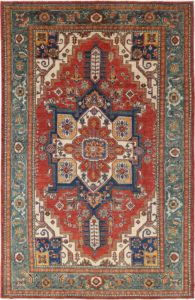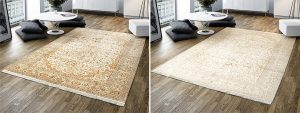The next time you visit a rug shop or if you have an oriental rug at home, try this exercise:
Stand at one end of the rug and look down the whole length of the rug. Observe the coloring of the field as well as the different motifs and the patterns in the field and border and take note of the various color tones carefully.
Now go across to the opposite end and do the same thing.
You will notice that the color tones of the field and the various motifs and patterns change significantly depending on which side of the rug you are standing at.
From one side, all of the colors will seem brighter whereas, from the other side, all of the colors will seem to be more muted. This is an interesting characteristic of most Persian rugs and Oriental rugs and there is a reason why the colors seem different.

Of course, this is just an optical illusion as you know it is the same rug.
The Answer
One reason for the changes in tones is because of the lighting of the room, which hits the rug from different angles.
How A Persian Rug Is Woven Also Create The Optical Illusion
Another major factor that creates this interesting optical illusion is the way that the rug is woven. While weaving the rug, the weavers tie each knot individually and all of the fibers are continuously pulled down. This creates the nap of the rug, which typically has all of the fibers lying along the same direction.
So from one end of the rug, all of the fibers may seem like they are pointing away from you, whereas, from the other end, all of the fibers will seem like they are pointing towards you.
The colors will appear brighter and the details will appear sharper when the pile is pointing towards you and the colors and details will appear muted and less sharp when the pile is pointing away from you.
In some rugs, the change in color intensity may be just a shade different but in others, the variation could be quite considerable.
Other Factors Affecting Color Variation Of The Rug
The degree of change would be dependent on the materials used in constructing the rug as well as the length of the pile. Silk rugs and rugs made from finer wool have a more marked difference.
Because of these color variations, the way you place your rug in your room can make a major impact on the overall look of the room and you have to turn it around 180 degrees to get the look you wish to achieve.
What kinds of experiences have you had with this interesting illusion?
Do you often rotate your rug to get a different experience of colors and highlights?
Share with us in the comments below.



3 thoughts on “Why Do Oriental Rugs Look Different From One End To The Other?”
I ended up returning the rug the color variation was so bad. I return the rug for a different one and realized when I got home I had the same problem. It’s absolutely horrible
I regard the color difference as one sign that the rug was constructed well and from good quality wool. I usually have a very strong preference for placing the rug the way I see the colors I prefer and not rotating it. But I do worry about the fact that I am not rotating it. Can you give us some tips for how we can keep the rugs in good shape when we are not periodically rotating them? Thank you.
Yes there are at least 3 things that rotating the rug help out with. I will explain them below and try to give you tips on what you can do if you decide not to occasionally rotate the rug.
1. Sunlight: Balancing the direct sunlight that the rug gets in its current position is very important. When you rotate the rug you are making sure that the color will fade more evenly if there is a specific angle and location the sunlight is hitting the rug. Otherwise one area of the rug will look more muted in color than the rest. So if you’re not planning to rotate the rug, I recommend at using the curtains during the hours the sun is hitting the rug directly. To protect the rug from direct sunlight when the sunlight will cause the most amount of fading. This is a general good practice even if you rotate the rug.
2. Heavy Furniture: If you have heavy furniture such a dining table, couch, coffee table on the of the rug.. over time if the furniture is sitting on the same spot of the rug, it can potential cause damage to that spot. This is another reason rotating helps so that the specific spot on the rug gets to take a break from the pressure exerted on it by the furniture. For this reason, if you not planning to rotate the rug, then at least move the position of the rug slightly to give relief to those pressure points.
3. Traffic: Similar concept as heavy furniture, a lot of foot traffic over one part of the rug will eventual cause wear over that area of the rug. So this is another reason why rotating is helpful. If you not planning to rotate then perhaps use some furniture or some external method to “detour” the traffic from that usual foot traffic pattern over the rug.
Overall the theme here is to balance the wear and usage of the rug so that it wears evenly and slowly. This will keep the rug in “good health” as it’s being used evenly. One could draw many parallels to the human body and a rug in this case.
I hope that helps!